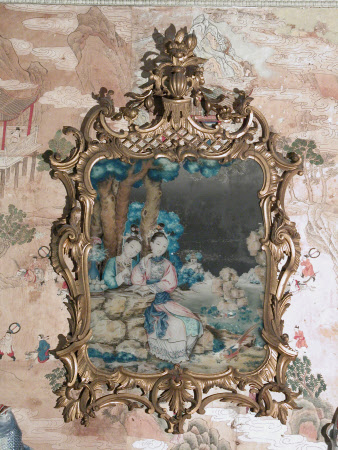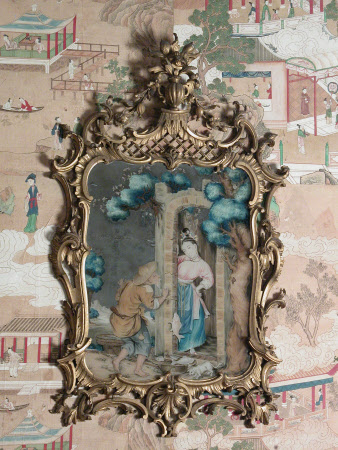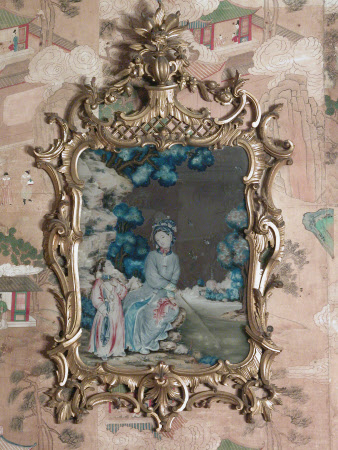Mirror
Category
Mirrors
Date
c. 1760
Materials
Glass, mercury, pigments, wood, gold.
Place of origin
Guangzhou
Order this imageCollection
Saltram, Devon
NT 872228
Summary
Group of six mirror paintings, glass, mercury and pigments, portrait format, made in Guangzhou (Canton), Guangdong province, China, c. 1760, in carved and gilded wood English rococo-style frames, depicting (1) a pair of female figures seated at a rockwork table in a garden reading a book, a pheasant nearby; (2) three female figures seated at a carved stone table in a garden, a stone balustrade behind, engaged in putting flowers in their hair, a pheasant at their feet; (3) two female figures standing between the edge of a lake and a rocky outcrop, showing a tame bird to a child; (4) a female figure standing in a doorway engaging with an old man holding up a fish; (5) a female figure seated on rockwork holding a fishing rod into a lake or a stream, a young girl next to her; (6) two female figures seated at a carved stone table in a garden, one arranging flowers in the other’s hair. Part of a group of eight Chinese mirror paintings in English rococo frames at Saltram, see also NT 872171.1-2..
Full description
Chinese mirror paintings (or reverse glass paintings) were particularly fashionable in Europe during the second half of the 18th century and the early 19th century. The mirrored glass was made in Europe and shipped to Guangzhou where some of the mirrored surface was removed and painted on. This resulted in the creation of hybrid mirror-paintings which were then shipped back to Europe as decorative objects reflecting (in more ways than one) the fictionalised European conceptions of China. The origins of this type of object may lie in 1664, when the Dutch East India Company presented some glass mirrors to the Kangxi Emperor. The earliest known mention of Chinese mirror paintings in Britain dates to 1739, when six of them are recorded arriving in London by ship (Audric 2020). One of the subjects depicted on Chinese mirror paintings is the meiren 美人 or ‘beauty’, an idealised representation of elegantly dressed women (in either Han-Chinese or Manchu costume), engaged in cultured pursuits in luxurious interiors or gardens – a type of image that already had a well-established history in other forms of Chinese pictorial art (Cahill 2010). The subject of NT 872228.5, of the woman fishing, can also be seen painted on the Chinese House at Stowe (NT 91820), in a decorative scheme probably originally created in the 1820s. Presumably the designer or creator of that scheme was aware of Chinese mirror paintings like the group at Saltram. Another mirror painting depicting a woman fishing is illustrated in Audric 2020. One of these mirror paintings was backed by a piece of paper inscribed ‘Bird & fflowers cut out of India paper for filling in vacancys in other paper – March 1757.’
Provenance
Accepted by HM Government in lieu of inheritance tax, 1957, and lent to the National Trust for display at Saltram; transferred to the National Trust, 1984.
References
Audric 2020: Thierry Audric, Chinese Reverse Glass Painting, 1720-1820: An Artistic Meeting between China and the West, Bern, 2020, pp. 29 & 60 Cahill 2010: James Cahill, Pictures for Use and Pleasure: Vernacular Painting in High Qing China, Berkeley, Los Angeles and London, 2010.





